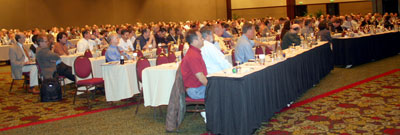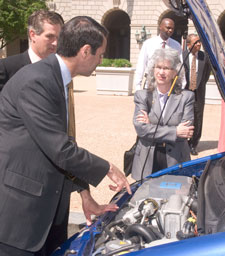Energizing EPA


The Energizing EPA newsletter highlighted EPA’s efforts to improve energy and water efficiency at its facilities. While the publication has since been discontinued, you can read past articles to learn about former EPA initiatives, technologies, alternative energy sources, and EPA's energy and water usage and savings. The newsletter was formerly circulated to EPA facility managers and other EPA employees. Archived issues of the newsletter dating back to January 1999 are available.
Last issue: February 2008 (PDF) (4 pp, 1.9MB, About PDF) (Printer-Friendly Version)
- Labs21 Conference in Charleston Continues Sustainable Growth
- Labs21 Is Honored With Presidential Award
- EPA Helps Drive the Future of Hydrogen Vehicles
- Regional Laboratories Create Less Waste, More Innovative Solutions
- Meet EPA's New Recycling and EMS Coordinator
- Catching Rain at EPA Headquarters
- Awards for Greening EPA
- New Law Energizes Efficiency in the Government
- Events to Catch!
Labs21 Conference in Charleston Continues Sustainable Growth

Conference attendees learned about sustainability efforts in Charleston, South Carolina, at the opening plenary.
In October 2007, 565 laboratory and facility professionals from the United States and around the world gathered in North Charleston, South Carolina, to discuss sustainable, high-performance laboratory efforts at the Laboratories for the 21st Century (Labs21) 2007 Annual Conference.
Co-sponsored by EPA, the U.S. Department of Energy (DOE), and the International Institute for Sustainable Laboratories (I2SL), this year’s conference boasted nearly 70 technical sessions addressing a variety of topics, from water management to commissioning. In addition, 60 organizations exhibited at the technology and services fair. The Labs21 program, which began in 1999, continues to expand its reach to new countries and organizations in the laboratory community and to include new ideas for creating sustainable laboratories. As part of the program’s expansion, and through the efforts of co-sponsor I2SL, the conference took on an even stronger international focus this year with workshops and symposia highlighting the region-specific challenges facing sustainable laboratories in Europe, the Middle East, North Africa, and Australia.
At the close of the conference, attendees had an opportunity to participate in a tour of Noisette, a sustainable community being constructed on 3,000 acres of the former Charleston Naval Base. The tour brought to life various aspects of this year’s keynote address on the project and included viewing the Warren Lasch Conservation Center's laboratory, home to the H.L. Hunley submarine—a Civil War-era Navy fighter submarine raised from the ocean floor in 2000. Attendees also had an opportunity to tour the Medical University of South Carolina (MUSC) campus, including the Ashley River Tower hospital facility scheduled to open in 2008, and MUSC’s existing energy plant.
The Labs21 Conference continues to be one of the largest gatherings of sustainable laboratory professionals in the country. The Labs21 2008 Annual Conference is scheduled for September 16-18 at the San Jose McEnery Convention Center in San Jose, California. For more information on Labs21 or the Labs21 Conference, please visit the Labs21 Web site.
Labs21 Is Honored With Presidential Award
Labs21 has won the 2007 Presidential Award for Leadership in Federal Energy Management! The award recognizes outstanding achievement in energy and water efficiency, use of new technologies and renewable energy sources, innovative strategies, and alternative financing.
Since its inception in 1999, Labs21 has made significant contributions to sustainable laboratory development. The Labs21 Annual Conference is one of the largest gatherings of sustainable laboratory experts in the nation. Training workshops, best practice guides, and case studies educate engineers and architects.
Labs21 representatives were honored at a ceremony in Washington, D.C., on November 2, 2007.
EPA Helps Drive the Future of Hydrogen Vehicles

EPA Assistant Administrator Luis A. Luna and GM representatives wrapped up a successful road-testing program of the HydroGen3 fuel cell vehicle.
In May 2007, EPA received a sneak preview of what’s on the horizon for alternative fuel vehicles. Representatives from EPA participated in a 15-month road-testing of GM’s HydroGen3, a prototype hydrogen fuel cell vehicle.
In addition to reviewing the road-testing program’s objectives and accomplishments, the participants discussed the possibility of continuing the partnership in 2008 when the successor to the HydroGen3—General Motor's (GM’s) next-generation Chevrolet Equinox Fuel Cell vehicle—will be available to select customers in California, New York, and Washington, D.C.
Throughout the fuel cell vehicle testing program, EPA was able to experience the HydroGen3’s pollution-free automotive technology. For GM, the program provided valuable data on how the vehicle operates under real-world conditions, such as city traffic and a wide range of temperatures. While the HydroGen3 is not a commercial vehicle, GM is applying the information gathered during this program to next-generation fuel cell cars that are currently in development. GM representative Raj Choudhury pointed out during the meeting, “General Motors is proud to partner with EPA as we work to develop exciting advanced technology vehicles that will offer a wide range of benefits to our customers. This program has provided valuable information about the performance of hydrogen fuel cell vehicles and will directly benefit our research and development activities.”
The original lease on the car, established in December 2005, was for six months; the program’s continuing success, however, led to a nine-month extension, bringing it to an end in March 2007. As part of the project, five trained EPA drivers, accompanied by a GM engineer, drove the HydroGen3 twice a week for a total of 1,700 miles. Drivers averaged approximately five hours in the car and 15 miles traveled each day.
As a final wrap-up to the meeting, GM provided EPA with a glimpse into the future of hydrogen fuel cell vehicles. The company has just begun the launch of a fleet of more than 100 Chevrolet Equinox Fuel Cell vehicles in a program dubbed “Project Driveway,” which represents the largest market test of fuel cell vehicles to date. Project Driveway will provide comprehensive customer insight from a diverse group of people who will be able to test-drive and refuel the Equinox, including government employees, the military, politicians, businesses, media, celebrities, and the general public.
During the meeting at EPA Headquarters, both groups shared their appreciation for the opportunity to partner in the HydroGen3 demonstration program, including EPA’s Assistant Administrator Luis A. Luna. “I want to thank GM for the work that it did with our staff, helping the Agency test-drive the HydroGen3, and allowing us the opportunity to showcase this technology,” he said in his opening remarks. “By forming this partnership, EPA was given an opportunity to show that we can ‘drive the talk’ and that environmental protection is something that can be done in a creative and technologically advanced way.”
Why Hydrogen and Fuel Cells?
Vehicles such as the HydroGen3 make use of a fuel cell, which combines hydrogen from an onboard storage tank with oxygen from the air to produce electricity and water. The electricity is used to power an electric motor that drives the vehicle. During this process, water vapor—the car’s only emission—is released into the atmosphere. This system replaces the traditional vehicle’s internal combustion engine, transmission, and gasoline tank, which avoids emissions of the greenhouse gas carbon dioxide. In addition, the hydrogen fuel supply can be obtained from a wide range of sources, including domestically produced renewable sources.
Regional Laboratories Create Less Waste, More Innovative Solutions
Over the past several months, EPA has been assessing Agency laboratories across the country for innovative recycling efforts and waste prevention best practices. Three laboratories in particular serve as models for novel ways to reduce waste.
The Atlantic Ecology Division (AED) laboratory in Narragansett, Rhode Island, has garnered local media attention for recycling a wide array of materials. The laboratory recycles packing and shipping materials, toner cartridges, and electronic equipment, among other items. Some of AED’s other waste prevention practices include implementing sustainable landscaping to conserve resources and using salvaged boulders to create security barriers instead of purchasing new materials.
Employees at the Environmental Science Center (ESC) laboratory in Fort Meade, Maryland, collect old shoes at an annual recycling drive; the soles are used to make playground equipment. ESC also donates excess laboratory equipment and chemicals to local universities for reuse. To streamline this process, ESC provides universities with access to a special database that lists available materials.
The National Vehicle Fuel and Emissions Laboratory (NVFEL) in Ann Arbor, Michigan, collects scrap metal generated in engine and vehicle testing and remodeling projects for recycling. The results are impressive: in 2006, NVFEL recycled more than 40 tons of scrap metal. Employees also reuse equipment and supplies as often as possible and recover old ductwork, furniture, pallets, and wiring for a second life.
Meet EPA's New Recycling and EMS Coordinator

Dexter Johnson
Overseeing EPA’s national recycling program and EPA Headquarters’ Environmental Management System (EMS) is no small task, but Dexter Johnson is up to the challenge. While he has worked at the Agency for less than a year, already Dexter is using his background in sales and management to invigorate recycling. For example, he has been helping EPA meet its Agencywide waste diversion goal of 45 percent by 2010, in part with his efforts on the recent battery recycling initiative, which has collected more than 450 pounds of batteries since July. On the EMS side, Dexter helped create a system that tracks participation in general awareness training on the Headquarters’ EMS Web site. This tracking system will monitor the Agency’s efforts to train employees on how to reduce their environmental footprints.
Dexter also performs recycling and pollution prevention assessments at EPA facilities, during which he meets with facility managers and EMS coordinators across the country to serve as a resource and offer suggestions for improving their recycling programs.
If you have questions or would like suggestions for your facility’s recycling program, please contact Dexter (johnson.dexter@epa.gov) at (202) 564-0179.
Catching Rain at EPA Headquarters
Soon a new irrigation system designed to capture rainwater will help EPA Headquarters conserve water and better manage stormwater. The system will consist of six 1,000-gallon cisterns at the base of the West Building’s parking garage on Constitution Avenue in Washington, D.C. The cisterns will collect stormwater falling from the rooftop, which can later be used to irrigate nearby landscaping. The project is scheduled to be complete by early 2008. For more information, please visit EPA Headquarters Low Impact Development Web page.
Awards for Greening EPA
In 2007, the Agency has been recognized with a number of sustainability awards.
Denver Region 8 Office
U.S. Green Building Council’s LEED® Gold Certification
DOE Federal Energy Saver Showcase Award
Potomac Yard Facility
White House Closing the Circle Award
DOE Federal Energy Saver Showcase Award
ENERGY STAR® Building Label (Potomac Yard One)
Ariel Rios South Courtyard
U.S. General Services Administration’s (GSA's) Achievement Award for Real Property Innovation
Steve Dorer, National Vehicle and Fuel Emissions Laboratory
DOE Federal Energy and Water Management Exceptional Service Award
New Law Energizes Efficiency in the Government
When President Bush signed the Energy Independence and Security Act into law on December 19, 2007, he didn’t just set a mandate to increase vehicle fuel efficiency—he challenged federal agencies to increase their facilities’ efficiency as well. Building on the Energy Policy Act of 2005 (EPAct) and Executive Order (E.O.) 13423, the act seeks to further improve energy efficiency in the federal government, help enhance the market for alternative fuels, and, ultimately, reduce greenhouse gas emissions.
Making Efficiency a Fixture
The new law reinforces the existing, aggressive requirement in E.O. 13423 that federal agencies reduce energy intensity 30 percent by FY 2015, compared to an FY 2003 baseline. To help agencies reach this goal, the law requires that, by FY 2013, federal buildings overseen by GSA be equipped with ENERGY STAR®-qualified lighting fixtures and bulbs or those designated by DOE’s Federal Energy Management Program. Starting in 2010, federal agencies will be required to lease space that has earned the ENERGY STAR label in the most recent year. Each agency must designate an energy manager responsible for implementing energy reduction measures at each facility. To help better monitor energy consumption, the law extends the existing requirements for the advanced metering of electricity to natural gas and steam.
The act also aims to reduce the climate change impacts of increased energy demand from new building construction. Federal buildings undergoing major renovations or new construction must be designed to reduce their fossil fuel-generated energy consumption (compared to a 2003 baseline) by 55 percent by FY 2010 and 100 percent by FY 2030. To meet these aggressive goals, federal agencies are being encouraged to continue using energy savings performance contracts (ESPCs).
Similarly, the law calls for GSA to establish green building standards for new federal buildings and to coordinate federal green building activities. It sets in place a zero net energy initiative, with the goal of having commercial buildings use no net energy by 2050. The law promotes federal government purchase of energy-efficient products and procurement of fuels with lower carbon emissions—and requires reports on the success of these efforts, along with taxpayer savings.
In addition to raising the national fuel economy standards, the law includes several provisions aimed at curbing petroleum use by federal vehicle fleets. For example, it requires agencies to procure low greenhouse gas-emitting passenger cars. Beginning in FY 2010, federal agencies must reduce annual petroleum consumption and be on pace to achieve at least a 20 percent reduction in petroleum use by FY 2015, relative to a FY 2005 baseline. Furthermore, federal agencies are required to increase the use of alternative fuels by 10 percent by FY 2015, compared to the same 2005 baseline.
Agencies can meet these goals by using alternative fuels; acquiring more fuel-efficient vehicles, such as hybrids; substituting cars for light trucks; increasing vehicle load factors; decreasing vehicle miles traveled; or decreasing fleet size.
"EPA is prepared to respond to this legislation through a combination of our sustainability efforts to date and forward-thinking planning to improve the operation and performance of our buildings and vehicle fleets across the country,” said Luis Luna, Assistant Administrator for the Office of Administration and Resources Management.
Reducing More of Our Footprint
While the law primarily focuses on energy efficiency, it includes several other sustainability requirements. For example, in an effort to minimize pollution from stormwater runoff on government landscapes, if a federal facility is developing or redeveloping a project affecting more than 5,000 square feet of outdoor space, the natural water cycle on the project site must replicate that which existed before the project began. This will encourage more low impact development projects such as the one currently being demonstrated at EPA’s Federal Triangle Headquarters in Washington, D.C.
Learn more about the Energy Independence and Security Act of 2007.
Events To Catch!
BuildingEnergy08
March 11–13, 2008
Boston, Massachusetts
www.buildingenergy.nesea.org ![]()
Greenprints
March 13–14, 2008
Atlanta, Georgia
www.greenprints.org ![]()
National Conference on Building Commissioning
April 22-24, 2008
Newport Beach, California
www.peci.org/ncbc/2008/ncbc_08.html ![]()
![[logo] US EPA](https://webarchive.library.unt.edu/eot2008/20090510110148im_/http://www.epa.gov/epafiles/images/logo_epaseal.gif)